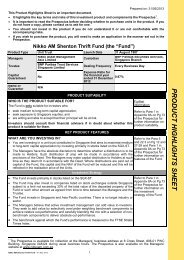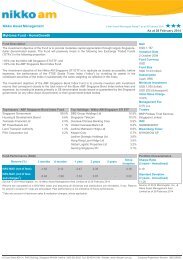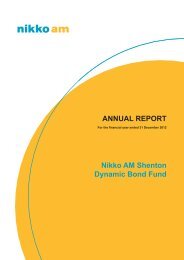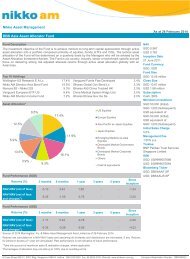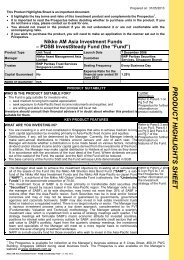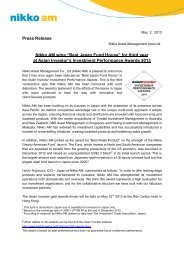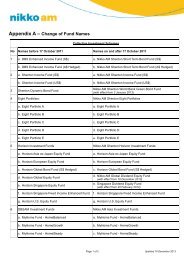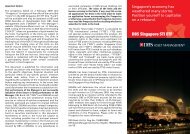Report - Nikko AM Asia Limited
Report - Nikko AM Asia Limited
Report - Nikko AM Asia Limited
You also want an ePaper? Increase the reach of your titles
YUMPU automatically turns print PDFs into web optimized ePapers that Google loves.
Subsequently, the Fund modestly underperformed the benchmark during 2Q 2013, which was a very difficult period for<br />
active fixed income investing. The primary detractor was an overweight to the emerging market debt (EMD) sector and<br />
an overweight to Mexican rates and currency. Other detractors included an overweight to German and UK rates and an<br />
underweight to EUR. These negatives were largely offset by exposure to non-agency mortgages; underweights to the<br />
US, French and Japanese sovereign rates; and underweights to the Australian Dollar as well as the New Zealand Dollar.<br />
On 9 April 2013, the Fund’s capabilities were enhanced by introducing an absolute return strategy (i.e. The Russell<br />
Absolute Return Bond Fund) that reduces interest rate risk but does not sacrifice yield. Our allocation was additive over<br />
the quarter as it reduced overall duration prior to the surge in interest rates.<br />
During the third quarter, the Fund posted positive absolute returns but underperformed its benchmark. Performance<br />
was held back primarily by currency positioning, notably underweights to the Australian Dollar, the New Zealand<br />
Dollar and the Euro. Mitigating this to certain degree were currency positives in the form of overweights to the<br />
Polish Zloty and Sterling and an underweight to the Indonesian Rupiah. Rates positioning was mixed, with negatives<br />
from overweights in Germany and New Zealand offset by positives from overweights in Australia and Ireland. Sector<br />
positioning dragged primarily due to an overweight to local currency emerging markets (overweight to Mexico and<br />
Brazil and an underweight to Czech Republic). An underweight to investment grade credit was secondary detractor.<br />
The Fund finished ahead of the benchmark over the fourth quarter, gaining from its duration underweight as yields<br />
inched higher over the period as well as its country, sector and currency positioning. An overweight to Irish rates, while<br />
being underweight to the UK and the US had a positive impact. In terms of sector selection, an overweight to high-yield<br />
and non-agency mortgages contributed, but exposure to local EMD detracted. Currency underweights to the Japanese<br />
Yen and the Australian Dollar and an overweight to the Polish Zloty further enhanced gains.<br />
Market Review<br />
Global fixed income markets remained dominated by policy and politics during the first quarter of 2013, impacted<br />
by speculation and outcomes in notable events as the US sequester and debt ceiling, the inconclusive Italian election,<br />
the botched Cypriot bank resolution as well as the European Central Bank (ECB) and the US Federal Reserve’s (Fed)<br />
comments/minutes. The Bank of Japan’s (BoJ) loose monetary policy (whose actual size surprised the market in early<br />
2Q 2013) evolved along with other central banks, who took efforts to ‘jaw bone’ their currencies down (ECB, Norway<br />
and New Zealand). Most economic and market trends broadly continued, including positive US growth (despite the<br />
2% payroll tax increase) and housing market, declining European economy and moderating global inflation. In USD<br />
unhedged terms, the Barclays Global Aggregate Index returned -2.1% over the quarter, with the negative total return<br />
driven by the sell-offs in EUR (on Draghi statements, Cyprus), GBP (on Bank of England indicating it might tolerate<br />
higher inflation) and JPY (on the US asset purchases expectations). 10-year US treasury (UST) yields increased modestly<br />
over the period, rising 10 basis points (bps). Investment grade corporate credit outperformed governments on a<br />
duration-adjusted basis. This was led by financials, whose yields are now back down to their traditional position below<br />
that of industrials. The US financial spreads have tightened due to the improving asset quality of their loan books<br />
and increasing capitalization. High-yield corporates did very well and outperformed most other sectors, given their<br />
attractive yield levels, strong credit fundamentals and continuing low default rates. Agency mortgage and commercial<br />
mortgage-backed securities spreads widened a bit and underperformed governments due to investor preference for<br />
riskier sectors. Non-agency mortgages continued to stand out with exceptionally strong performance, given the sector’s<br />
supply constraints and the positive fundamental backdrop of the US housing market. Though it struggled over the<br />
period, emerging markets hard currency outperformed the unhedged Global Aggregate index. Falling commodity<br />
prices, continued high issuance and devaluing emerging market currencies against the USD contributed to the pressure<br />
on EMD.<br />
Global fixed income markets performed poorly in 2Q 2013, closing out their worst first-half since 1994. The Barclays<br />
Global Aggregate Bond Index posted negative returns of - 2.79% for the quarter and -4.83% during 2H 2013. The key<br />
driver was a surge in the US interest rates, fuelled by the US Fed Chairman Ben Bernanke’s Congressional testimony<br />
on 22 May 2013 (and reiterated at the Federal Open Meeting Committee (FOMC) meeting on 19 June 2013) that the<br />
Fed could “taper” its stimulative bond-buying program before year-end if the economy continued to improve. For<br />
the quarter, the 10-year USTs rose 63bps to 2.48%, nearly a two-year high. While rising US rates caused German and<br />
the UK governments to post negative total returns, peripheral European treasuries bucked the trend with declining<br />
rates and positive returns. These bonds saw firm demand due to comments from ECB President Mario Draghi that the<br />
central bank “stands ready to act when needed”. Japanese government rates were also pulled up by rising US rates,<br />
despite the BoJ embarking on a large quantitative easing (QE) effort of its own. Over the quarter, virtually all spread<br />
9




